Saturday 15th January 2022

As bus and train companies make service cuts to cater for reduced staff availability due to the continued impact of Covid’s Omicron variant I can’t help wondering whether the consequential slimmed down networks will become the “new normal” as passenger levels continue trailing 25-30% below pre-pandemic times and the Treasury plays hardball on funding support.
Even if staff absence levels improve over the next few weeks what incentive will there be to restore lost services and frequencies with passenger numbers still in the doldrums? All the more so with many bus companies still struggling with a structural shortage of drivers.

As a short term expedient it makes sense for operators to introduce revised schedules calling for fewer staff when faced with a significant shortfall in resources rather than try and deal with last minute unplanned cancellations as some are doing (eg TrentBarton as above). It causes a lot of extra work for operational staff trying to keep on top of a changing situation day by day and hour by hour and it’s hopeless for passengers not knowing whether they’ll catch a bus or train at the expected time. As we all know, there’s no better way to turn off passengers from the idea of using public transport than a strong dose of unpredictability and unreliability.
Far better to manage the situation by withdrawing journeys or services on an organised basis until the situation improves so everyone knows where they are. Except “until the situation improves” in the current scheme of things has a broader context, not least the continued uncertainty of Government funding support.
I’ve commented before on the ludicrous situation in London where TfL are having to run their multi billion pound business on a hand-to-mouth basis dependent on eleventh hour and fifty-ninth minute conditional agreements with Government as funding deadlines are about to expire; the next drama already set for three weeks time on Friday 4th February.
I know the Government’s keen to move the public agenda from ‘partygate’ back to it’s famed buzz worded ‘levelling up’ (whatever it means) but I didn’t realise that meant the rest of the country’s public transport having to face similar cliff edge uncertainties on funding matching London’s modus operandi.
Colleagues in the bus industry tell me the mood music from the DfT is Bus Recovery Grant in some form will continue beyond its current deadline of the end of March thus avoiding mass de-registrations of bus services but discussions with the Treasury on the detail are still not finalised. Great. Once again bus operators have to put faith before facts when it comes to funding.
Concessionary fares reimbursement in England is already destined to reduce from April causing a financial headache.
A similar position is facing those Combined Authorities operating light rail and tram systems with no certainty of supportive funding beyond the end of March. Being public bodies they have to be more upfront about the likely implications.
Nowhere is this more pertinent than in the north east of England where Council leaders are wrestling with a projected £21 million deficit for Tyne & Wear’s Metro light rail system. And with echoes of what’s happening in London, the Newcastle Chronicle reported on Tuesday “devastating cuts to vital North east bus services are set to be signed off amid a deepening budget crisis and bosses now warn that the Tyne and Wear Metro could soon be in the firing line too.”

In what should serve as a stark warning to Mayor Burnham and his fellow proponents of bus franchising in Manchester, the Chronicle reports PTE colleagues in Tyne and Wear are planning to “protect the Metro from service reductions during 2022/23 on the grounds that slashing the number of trains it runs would result in a catastrophic fall in ticket revenue and ultimately force the system to shut down entirely”.

The timing couldn’t be more unfortunate for the Metro. A brand new £362 million train fleet is currently in build with new depot facilities in Gosforth under construction to house and operate the new trains as Nexus leaders stated on Monday “cuts to the Metro remain a longer term option for the years ahead”.
The North East Joint Transport Committee is being asked to approve a budget next week which includes: £7.5 million reduction in funding for concessionary fares reimbursement due to bus operators which will cause a knock on effect to the viability of bus routes; £2.4 million ‘efficiency savings’ from the Metro including a pay freeze which will go down like a lead balloon with staff and trade unions; £1.6 million from fare increases; £5.6 million from Nexus ‘reserves’ – something that’s not sustainable in the long term; and asking the five Tyne and Wear councils to increase their levy payments to Nexus by £4.1 million which won’t be popular with those authorities.
I can’t believe the situation is markedly different for Manchester Metrolink’s finances which makes you wonder how its budgets are shaping up.
Meanwhile on Wednesday the Guardian carried an article over two pages in its Financial section telling readers “bus services in England used by hundreds of thousand of people are poised to be slashed when emergency Covid funding expires at the end of March, transport authorities have warned”.

It points out the Bus Back Better strategy pledged £3 billion in funding to “transform services” but the autumn budget confirmed only £1.2 billion. CPT reckon the commitments in the Bus Service Improvement Plans currently being assessed require £7 billion investment. And that’s before BRG 2 is taken into account.
The article quotes Tracy Brabin, the first elected Mayor of West Yorkshire, “a better bus network is vital for us in West Yorkshire. My concern is that the £3 billion we were promised has been reduced and a lot of that money is being used to hold up the existing service rather than transform it was we wanted to do”. The stark financial reality is no doubt giving her cause to rethink the idea of “taking back control” of buses through franchising.
Cuts in frequencies on the National Rail network are also continuing (due to staff unavailability) and I wouldn’t be surprised if many of these timetable reductions become permanent to meet the Treasury’s demand for a ten per cent cut in costs. South Western Railway and Avanti West Coast are the latest train companies to announce reductions from tomorrow. Avanti’s new timetable sees frequencies reduced to hourly to both Birmingham and Manchester as well as Glasgow and Liverpool. Even at the height of 2020’s first lockdown, when passenger numbers were around 5% of normal, more trains ran.

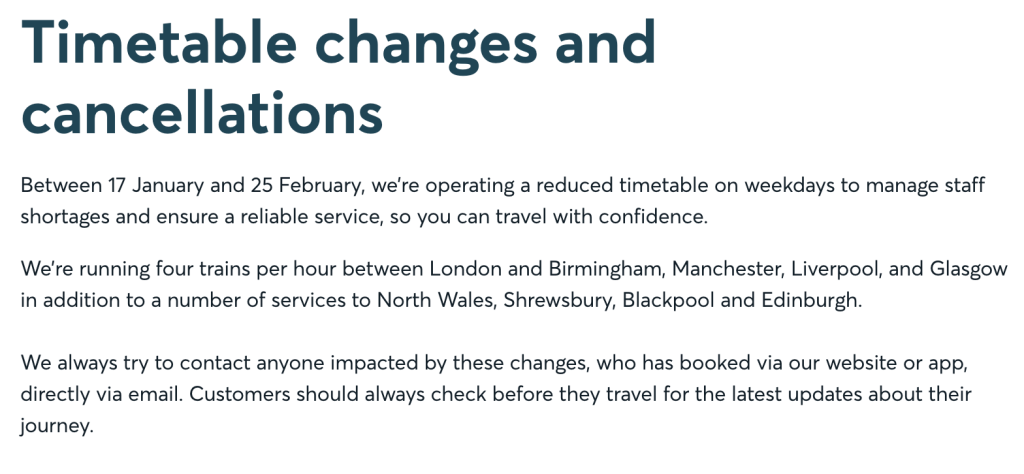
To be parochial I continue to be mystified by Southern’s withdrawal of trains between Sussex and Victoria. A four-trains-an-hour shuttle between East Croydon, Streatham Common, Clapham Junction and Victoria began on Monday but there’s currently no sign of this arrangement ending any time soon.
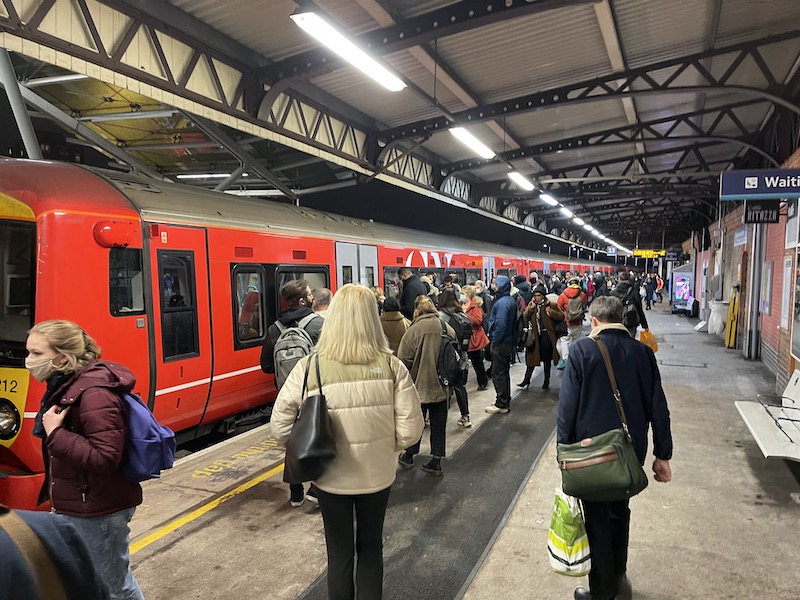
It forces thousands of commuters to change trains at East Croydon at great inconvenience. The puzzle to me is how such an arrangement actually saves any staff resources with trains from East Grinstead and coastal destinations on the Brighton Main Line simply continuing to London Bridge rather than Victoria. As I wrote in a previous blog, it just doesn’t add up.

It really is a hassle to travel up and down the Brighton Main Line at the moment, especially when needing to get to Clapham Junction for onward travel with SWR as I did twice this past week.
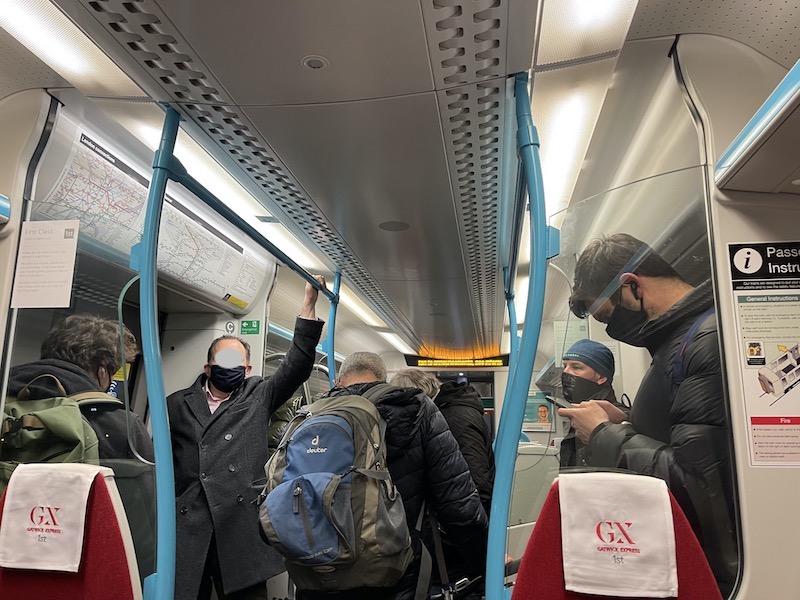
Returning south in the evening peak, a 12 coach East Croydon bound train on the shuttle pulled into Clapham Junction already well loaded and then got absolutely “rammed” with standing passengers in many of the coaches including “first class”.
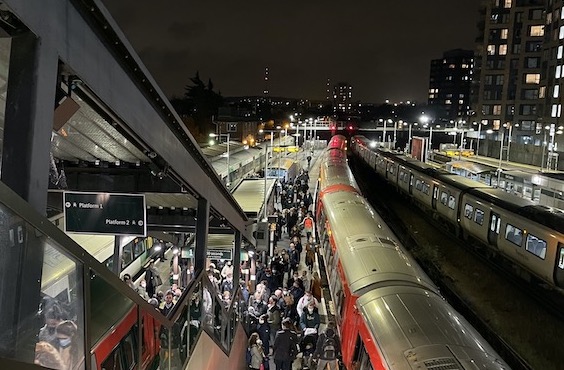
Of course, at East Croydon everyone has to get off the train on Platform 2 (which has been turned into the ‘turn back’ platform) and either exit the station up the slope at the south end or in most cases transfer over to Platform 3 for Sussex bound trains using the staircase and footbridge in the middle of the station which can barely cope with the peak demand each time a full to capacity train arrives and with passengers coming down the stairs too.

The whole arrangement is very unsatisfactory and this weekend sees yet another blockade on the Brighton Main Line between Three Bridges and Brighton/Lewes so suddenly trains are running again between Three Bridges direct to Victoria (six an hour) yet come Monday, they’ll be back to being diverted to London Bridge with Victoria bound passengers forced to change on to the East Croydon shuttle. Although I note Southern have announced the Bognor Regis/Portsmouth Harbour/Southampton Central trains will be restored to Victoria from Monday but as I write this on Friday precise details have yet to be loaded on to websites and journey planners. And passengers are advised to “plan ahead”. Fat chance.
Ironically a signal failure late on Friday afternoon between East Croydon and London Bridge caused considerable disruption to services and some Southern trains were diverted into Victoria instead of London Bridge, where they should have been going in the first place. It’s just such a totally bizarre situation.

Meanwhile residents in the villages of Swallowfield and Riseley in Berkshire lose their bus route after today as Reading Buses “suspends” operation of ‘tiger’ branded route 7 between Reading and Fleet. This is a good example of a Covid inspired staff unavailability cut which is unlikely to be restored.

It’s not just staff issues though. Reading Buses announcing the “suspension” on Thursday last week explained “long term roadworks between Hartley Wintney and Fleet are causing a significant fall in the number of people able to get to the service. We have also seen a vastly reduced number of customers using this service since the start of the pandemic”.
Route 7 has a fascinating history which goes right back to Aldershot & District’s route 12 between Aldershot and Reading. If you’re interested there’s a potted history here on the Hants & Surrey Bus Blog.

Suffice to say bus companies as disparate as Tillingbourne, Countywide Travel, Fleet Buzz and Stagecoach have all given the route a go prior to Stagecoach splitting the route in Fleet in April 2018, henceforth only operating the southern section to Aldershot, leaving Reading Buses to bravely take on the northern section to Reading.

Until today’s last day of operation the timetable had reduced to just five return journeys between Reading and Fleet operated by one bus with a couple of localised journeys as far as Spencers Wood in the morning and what I assume are three tendered journeys in the evenings as far south as Riseley, ironically to as late as 23:48!
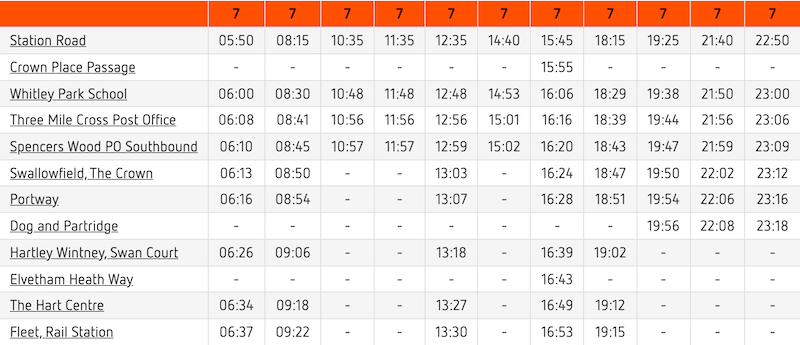

I caught the 12:35 journey from Reading to Fleet on Thursday and in view of the imminent service suspension was surprised to see as many as 15 fellow passengers board with me, although four alighted as we left Reading and in nearby Spencers Wood where alternative buses are available. But that left 11 on board for who there will be no alterantives.

Five of these alighted in Swallowfield and one in Riseley with three more getting off in Hartley Wintney leaving two travelling on to the terminus at Fleet station with myself.

The driver got out the cab when we arrived in Hartley Wintney to explain to the man wanting a bus stop on the normal route down to Fleet that this was as far as he could travel as the road closure meant the bus was about to continue on a significant diversion to reach Fleet.

Similarly the two passengers wanting the shopping area of Fleet had to walk there from the station.
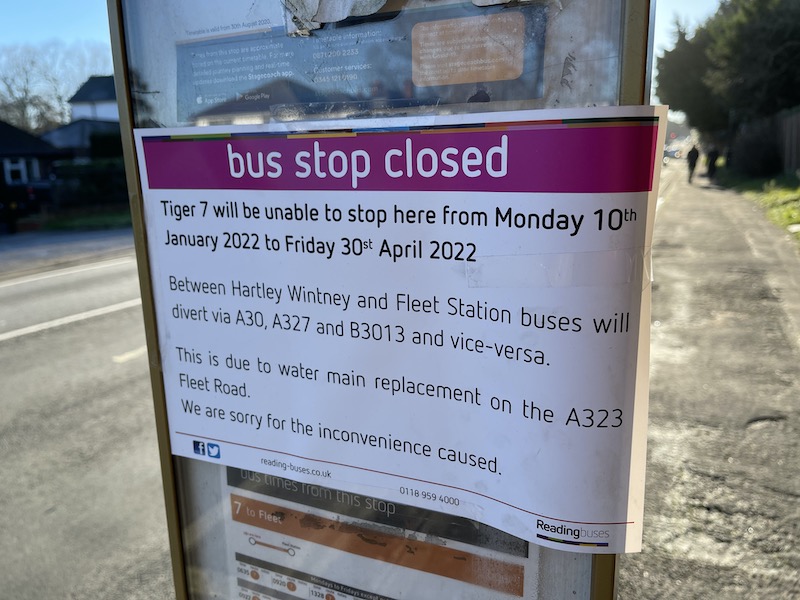
I also walked the ten minutes or so into Fleet’s commercial centre from the station and waited for the Stagecoach southern section of route 7 to travel onwards to Aldershot.

This takes a circuitous routing through Fleet having commenced in the residential area of Elvetham Heath. Like the northern section, the frequency is fairly low at just seven daytime journeys a day, two of which continue to Hartley Wintney.

I caught the 14:22 journey from Elvetham Heath down to Aldershot and sadly have to report only two other passengers travelled with me, both boarding in Fleet; one travelling just a few stops and the other to the northern part of Aldershot. Not very encouraging.
I feel very sorry for residents of Swallowfield and Riseley who use the bus regularly to get their shopping and other needs in Reading. They now have no public transport. If they’re key workers, they’re stuffed. But from Reading Buses’ perspective, it makes total sense when driver availability is under strain to maintain frequencies on busy town routes like route 17 used by thousands of passengers rather than an infrequent poorly used rural route (although 11 on board as far as Swallowfield is pretty good). All the more so when there is still no guarantee supportive funding from the Government will continue after March.
But I doubt those working in the Treasury are worried about such matters. They’re probably having a party.
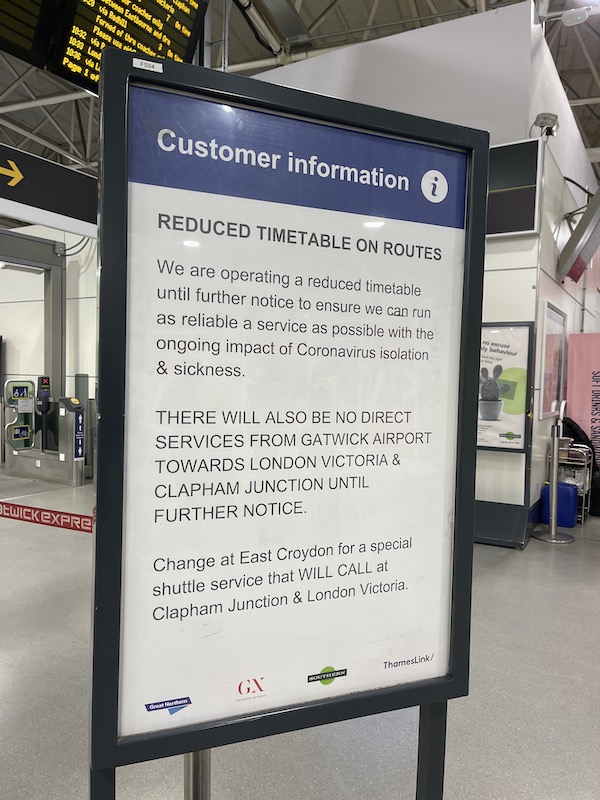
Roger French
Blogging timetable: 06:00 TThSSu.
Next blog, Sunday 16th January 2022: (the delayed) A is for Andover.

I know that there are quite a few children at schools in Reading who use route 7 from as far away as Hartley Witney (some of my friends did) – who knows what they will do now
LikeLike
Thanks for this important – and worrying – commentary. Re the roadworks caused by watermain work. Would it really not be possible to arrange the roadworks so that buses (but not other traffic) could still get through? Throughout my life, my bus journeys have regularly been disrupted – often with no notice – by roadworks, sometimes in a remote part of the route; connections, appointments, and life generally become difficult for many many people, and presumably the bus companies lose money over this.
From the start of rail privatisation, the track owner had to compensate operating companies for disruption – though the passengers rarely saw any of that. Have the bus companies never lobbied for a similar – or better – system? – where water/electric/gas etc. companies had to pay for good publicity about the roadworks and alternative routes for car-drivers, and/or extra buses to enable passengers to be able to travel with less worry?
LikeLike
I expect the 11 freehold passengers was that number because it was the only relevant journey for shoppers (before at 0815; after at 1545). It does go to show that any bus route withdrawal will affect some passengers . . . the determination has to be whether that number is significant or not.
I too worry about the longer term future of buses outside the conurbations . . . with Government advice still implying that travel by bus is dangerous for your health (whereas meeting for a meal in a restaurant, when diners are sitting closely for long periods sharing air . . . that’s OK!!) how can the industry ever hope to get more passengers on board.
Bus Back Better, in my view, is now a dead duck . . . there never was going to be sufficient funds; now there will be no significant money at all. If OAP funding reverts to paying just for those travelling; if Government reduces C-19 support funding . . . the only option has got to be reducing timetables. Hard decisions about what to fund and what to let go will be forced upon both operators and LTA’s.
As an example . . . a bus-rail route between Kemble and Tetbury has been running for decades; gradually reduced in scope every few years. I travelled on the route in December: 1110 ex Kemble carried 4 passengers; 1245 ex Tetbury carried only myself. Connection times were between 30 and 45 minutes at Kemble . . . and with trains passing there, a proper bus-rail connection could be easily achieved.
Sorry, but this route doesn’t deserve to continue. There will be many, many others across the country.
LikeLiked by 1 person
I think this is the start of the perfect storm, a combination of factors, the most pressing of which is the uncertainty principle, which implies that it is in general not possible to predict the value of a quantity with arbitrary certainty, even if all initial conditions are specified. Even the lauded passenger demand forecasting will not help much here and operators are tied into an estimated predict and provide based on revenue margins, unknown subsidy and potential varying demand. The logic dictates that it is better to under-provide than risk over-provision and the certainty of revenue loss. I have some degree of sympathy with those in government who have to make the hard choices, as I am sure they would rather pass on the revenue risk to the operator of bus and rail services rather than explain to the treasury where their budget has gone! This time of year has always been quiet for leisure travellers, but as the weather improves are we likely to see any passenger growth in line with a possible decline in Covid? That is yet another unknown. Who would want to be a driver rostering clerk at the moment when no amount of computing power will tell you what next week’s driver availability will look like! I really can see many more marginal services falling by the wayside as budgets are squeezed and staff reductions look ever more attractive – I fully expect to see the Scottish and Welsh governments start looking at the wages budget, but this will inevitably lead to a clash with the unions. One thing is certain, this will be a defining year as to how the future of public transport provision will be determined.
LikeLike
Glad to see you were on “our” route 7 on Thursday – so were we, but on the 0930 from Fleet and 1545 back.
The very skilled lady driver on the 0930 had to do a three point turn at Heckfield because of an accident blocking the road. It is our only easy way to get to Reading’s shops, including M&S and John Lewis, and for rail and bus trips from Reading [ as I did on Wednesday too], as the train steps are very difficult for my wife. We are in a state of shock here in Fleet. Hampshire CC say it is nothing to do with them as it is a “commercial” route. To which I replied that it is clearly now loss-making so, by definition HCC must now step up. A great amount of noise will now be made.
HCC also say our rail journey via Basingstoke is “step-free”. Ha! Ha! Have they ever been to Switzerland
with its often absolutely level access?
Have also heard, by chance, that our rail service is to be cut for a third time to only hourly , also from Monday 17th.;
That’s a two-thirds cut off peak, just when we are all itching to get back to London for leisure trips.
What is the Dept of Transport up to allowing this? It may be temporary, but does not say so. Some trains will be packed.
LikeLiked by 1 person
I would like to know how much taxpayers money has been spent staffing BSIPS, and the National Bus Strategy. If the Treasury undermines this work by denying the required funding then the money has been wasted. It is also yet another example of over promising and under delivering which is not good governance.
I wonder if other European countries are slashing their public transport provision in response to Covid? Will Swiss citizens cease to get their at least hourly rural buses seven days per week for twelve hours a day, that seamlessly connect with the trains? Why can’t a G7 economy afford such provision?
LikeLike
Sadly, the “perfect storm” indeed. Some of us predicted a permanent drop in bus passengers of 20-25%, and possibly more for national rail at commuter times, both of which seem to be reasonably accurate at the moment. What perhaps wasn’t predicted almost two years on was huge numbers of staff “isolating” (presumably anyone can claim the need for this without certification?) and adding to already bad staff shortages in the bus driver segment.
But the really interesting result of passenger numbers falling has been the highlighting of just how much it costs to run any type of rail system, and by contrast, how little should be required to operate a decent bus service. So while shovel fulls of cash are going to be required to keep the national rail network going, the Metro in Tyne and Wear and the few tramway systems even at reduced service levels, some areas will (and have already!) lose their vital bus service altogether for a minuscule fraction of the comparable cost.
There is no one particular single factor to blame (other than the source of Covid) and perhaps the national obsession with the motor car. But we are where we are, and if you are really passionate about public transport, strong words need to be made to all MPs and local Councillors.
LikeLike
Leveling Up probably means paying motorists to drive and knighting racing car drivers?
LikeLike
Politicians have been “rescuing” public transport for decades. And where has that got us, apart from into the present mess?
The only rescuer is the passengers, so perhaps we’d better start spreading the word rather than just talking to ourselves. But, the passengers can’t do it alone. Even areas with good passenger usage, have atrocious services. Why? When we can answer that one, may be we can make a start on sorting out public transport, rather than just making it another slanging match.
But perhaps we are just too addicted to the present chaos, or the money we make out of it.
LikeLike
I used the Victoria – East Croydon shuttle from/to Clapham Junction one day last week and was struck by the chaotic scenes at East Croydon. How did all the schoolkids manage when there was no service from Clapham Junction the previous week?
From Monday I have to experience the purgatory of the SWR “Omicron” timetable which I don’t think anyone believes is due to Covid staff shortages because SWR services have held up well in recent weeks. The timetable is merely the one that operated during last year’s lockdown, except of course we currently don’t have a lockdown. Surely corporate laziness and complacency at its worst. We have been told for the past year or so that the railways will focus on leisure travel yet SWR is decimating the weekday evening timetable thus forcing many discretionary evening out travellers onto other modes or not travelling at all.
What is depressing is that not only the DfT and the Treasury undoubtedly don’t care, but it seems that the TOCs don’t either.
LikeLike
Peter Nicholls wrote “What is depressing is that not only the DfT and the Treasury undoubtedly don’t care, but it seems that the TOCs don’t either.”
The TOCs take their lead from the DfT, especially at the moment while they’re all playing Fantasy Franchises. Of course they don’t care.
Roger wrote in the blog “The puzzle to me is how such an arrangement actually saves any staff resources with trains from East Grinstead and coastal destinations on the Brighton Main Line simply continuing to London Bridge rather than Victoria.”
It _doesn’t_ save any staff resources, just like the lockdown timetables didn’t. All that happens is that the staff who should be running the cancelled or deleted trains sit around in overcrowded messrooms* getting bored – and passing on any bugs they may have picked up…
* (overcrowded because the only action taken by most TOCs to deal with staff social distancing was to put signs in messrooms saying “X people only in this room” but didn’t actually do anything to provide sufficient space for the number of people needing to use those rooms, especially when the train planning department cancelled trains meaning there would actually be *more* people than normal needing messroom facilities).
LikeLike
Peter – the TOC’s do as the DfT tell them to in return for the management fee they pay them. The TOC’s have no choice in this matter and I suspect that the funding is subject to clauses which state that they cannot blame the DfT; but I’m not sure that the public is so naive.
LikeLike
They do blame the DOT and Network Rail all the time and where more than willing to take on these franchises but the CEO’s/MD’s won’t take any responsibility. . .”don’t look at me chief I’m only the CEO go and see Network Rail!”
LikeLike
“I’m not sure that the public is so naive.”
Oh, they are, they are, believe me.
I still have passengers telling me that “British Rail are ” and “should be dealt with”, and the worrying thing is that half of those people were barely out of nappies at privatisation. If they haven’t even noticed that BR ceased to exist 20-odd years ago, they certainly neither know nor care what role the DfT has in the debacle that is our railways.
Never mind, it’ll all be wonderful when it becomes Great British Railways. If it ever does, of course, as apparently that’s now been pushed back to 2027 at the earliest.
LikeLike
Outside of London there has been no subsidy for bus 98% are commercially operated , Constant cuts to services and reducing the routes to little more than a skeleton servicesand instability of the network is constantly driving people are from bus services in fact inm much of England there are no viable service to use. THe bus is just a transport more of last resort
Bus back better is a start but they already seem to have wasted a lot of that money. To get people back on buses there need to be good service operating at least 6 days a week from about 6am to 9pm and for town services at least a 20 minute daytime frequency
Additional money will be needed so bring back an annual charge for the bus passes and make a small tax on public car parking spaces
Unless money is invested in bus servicce the slow decline of them will continue. Some areas have invested and have seen passenger growth and better services d ev
The danger is politicans go in for grand very expensive Mtro trams et that cost a fortune and operate at a huge loss
LikeLike
A small tax on car parking spaces?Look at the space a single car takes up! Even a small family car takes up about as much space as 20 people squeezed in a box of equal size and bear in mind that small family car probably has one person in it 90 percent of the time.This doesn’t of course change if the car is internal combustion or electric….the car remains a thief of space and bear in mind there are 32 million of them in England,or that might be the 4 UK countries,but a lot either way you look at it.
LikeLike
LOndon to Manchester trains are being cut from every twenty minutes to every hour
LikeLike
Buses could be rescued fairly easily. A town wide system of bus priority would boost revenue and cut costs. There is no such thing as free parking, it is all expensively subsidised and this should stop. The difficulty is politics but it can be demonstrated by the example of Oxford etc that we could have cleaner air, safer roads and good buses . We also need a big campaign to show that the re-regulators are not telling the truth.
Rail is much tougher to fix but there is a lot of fat in the system to go at.
LikeLiked by 1 person
On Monday 10 January, Greater Anglia – in response to reduced passenger numbers – introduced a service ‘similar to a Sunday frequency’, with some enhancements in the peaks and at the start and finish of the day. It specifically wasn’t described as a ‘Sunday service’ as that would raise the expectation of Sunday (ie off-peak) fares all day.
Some overcrowding has clearly occurred at certain times of the day, so this Monday (17 January) sees the addition of a number of extra trains – predominantly in the morning and evening peaks.
If this pattern continues, it would appear that the railway is now moving away from a timetable change on two fixed dates each year, to a ‘rolling timetable’ which changes on an almost weekly basis. This is an eye-opener because, historically, it has normally taken a minimum of 12 weeks to implement even the smallest of changes to the railway timetable.
A consequence of such short term changes is, of course, that it is difficult for the passenger to plan future journeys with any certainty.
These are worrying times for the railway because, as previous commenters have pointed out, the fixed costs of running a railway are high.
LikeLike
Most of the rail changesare down to Covid. Brtter to have a reduced timetablr then randomad hoc cancellations
LikeLike
A point that I think is often missed with the various service cuts is that they invariably make journeys longer for a substantial group of passengers. Connections get longer, people who can’t control the time they finish work have a longer wait and if there’s disruption that leads to cancellations then what would previously have been 30 minutes to the next service becomes an hour. And that’s without even considering the likes of SWR introducing emergency timetables that have split services to Exeter and Weymouth with long waits for connecting trains. In real life these factors often make more difference to journey time than the actual point to point running time.
LikeLike